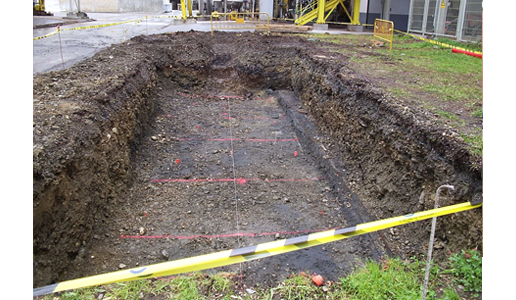Excavation works
Works in excavations
Civil works require moving massive amounts of earth, taking the form of cuttings, slopes and excavations, the most important hazards of which are:
- Those resulting from the use of machinery.
- Falls onto the same or a different level.
- Burials produced when carrying out work in areas at the highest point of slopes, transit in their vicinity and above all in the laying of foundations, drains and when waterproofing walls at the bottom of such works. It is necessary to guarantee:
- The stability of slopes using guniting or any other retaining system.
- Protection of the highest areas.
- Conditioning of access ways.
- Protection of works at different levels or avoiding these.
In urban areas, where the high cost of land and the need for underground car parks condition the construction of buildings entailing greater excavation depths, excavation presents a set of problems that are exacerbated by the modification suffered by the ground, old conduits, the transit of vehicles, etc., the most important hazards of which are:
- Falls onto the same or a different level.
- People being run over.
- Subsidence.
- Landslides and collapses, with the consequences of workers being buried.
Preventive Measures:
Design of the excavation
Excavating may be carried out in two ways, with or without constructing a prior retaining structure in its walls. The choice of one system or another will depend on the type of ground, on the stresses to which it is subjected, on the existence of adjacent buildings, etc., which will all define the type of protection to install.
Interior protection without a prior structure
The ideal solution would be to use natural slopes in excavations, but attempting to do so in a “box-cut” excavation with present-day excavation depths often becomes utopian. Nonetheless, when this system is not possible, it will be necessary to employ:
- SHUTTERING AND PROPS. A system that is usually conditioned by improvisation as a consequence of the formation of vertical slopes that are inappropriate.
- FOUNDATION TRENCHES AND SHORING. A combination of the two previous means though based on an alternative process, ideal for controlling and retaining earth in acceptable ground and for depths that are not excessive.
- DIAPHRAGM WALL. If so advised by the Works Supervisor.
Interior protection without a prior structure
Interior protection with a structure
- ANCHORED HANGING WALL, descending vertically by means of foundation trenches, where the perforation of a diaphragm wall is not achievable; being ideal for water-free cohesive ground, rocky ground or highly compacted earth.
- PILE AND MICROPILE WALLS. A suitable system in urban lots in which the foundations of adjacent buildings are weak or inexistent, thus preventing their collapse and subsidence.
Fencing off the lot
- In all excavation work, a 2 m high continuous fence must be installed around the perimeter, situated at an equal distance from the edges of the excavation, which makes it inaccessible to anyone not related to the works.
Exterior protection of the excavation
With the aim of preventing falls to the bottom of the excavation, the areas around the edges of the excavation or “box-cut” excavation must be protected by means of:
- Fixed fencing with railings and skirting.
- Signs and beacons, if it is not a transit or work area.
Defining access ways for personnel and machinery
- If possible, access of personnel to the bottom of the excavation is to be independent from that of vehicles and machinery by means of provisional fixed ladders for people.
- Access of vehicles and machinery is to be established via a ramp with a slope of 12% on straight stretches and 8% in bends, taking into account the manoeuvrability of the vehicles employed and the exit onto public thoroughfares, with slopes on the sides to counteract dynamic overloads.

Excavation with retention of the ground by means of the driving-in of piles and fencing around the perimeter

Excavation with slopes, fencing around the perimeter, an access ramp for vehicles and machinery and protection of the tops of slopes




